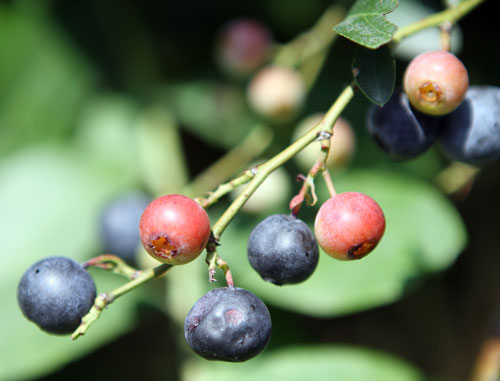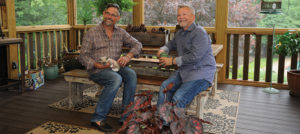
A family tradition
100 years in the making
By Carol Pappas
Photo by Jerry Martin
Born and raised near a town now under the waters of Logan Martin Lake, Mike Wadsworth went out to make his way in the world as a commercial artist. But the family farm eventually drew him back, continuing a legacy that has been 100 years in the making.
Wadsworth Farm, in the same family for 100 years, reached a milestone in 2011, earning both Heritage Farm and Century Farm designations from the State of Alabama Department of Agriculture and Industries.
Located just off US 231, south of Pell City, Wadsworth Farm is a remnant of an era gone by in an area known as Easonville before the Coosa River was dammed to create Logan Martin Lake in 1965. Most of what remains of the town now lies underneath Logan Martin, including part of the old highway.
As a boy growing up there, Wadsworth said, the family farm was surrounded by other farms — low-lying pasture land that enabled him to see all the way to present-day Voncile Lane, a road off Alabama 34 several miles away.
The farm started as a peach orchard in 1911 by his grandfather, William Lee Wadsworth. He and Wadsworth’s grandmother, Ella Ritch Wadsworth, had all their children in the house, and as the years passed, the family clan thrived.
It was more than a half century earlier that the original Wadsworth family first settled the area around Treasure Island on the Coosa River. Some were tanners and trappers, and they traveled the Coosa all the way to Wetumpka, trapping along the way and selling their pelts.
The story goes, said the modern day Wadsworth, that on one trip, the dealer would not pay what the group thought the pelts were worth. They pooled their money and could only buy one train ticket. One man returned home on the train with the pelts while the rest of the group walked back to Easonville from Wetumpka.
Another story handed down is the purchase of the first “store bought” match, when his grandfather sent for the children to witness a match struck for the first time.
 It was a time when his grandfather and a great uncle operated two syrup mills, and 630 gallons of syrup could buy his great uncle, George Ritch, a brand-new, 1930 Chevrolet.
It was a time when his grandfather and a great uncle operated two syrup mills, and 630 gallons of syrup could buy his great uncle, George Ritch, a brand-new, 1930 Chevrolet.
Wadsworth also recounted hard times, where families knew they could “always go see Mr. Lee” for the basics, like corn, syrup and eggs. “It’s hard to believe people lived on that,” his wife, Jeanette, said. But they were able to get their iron and protein in those basics from ‘Mr. Lee.’
Excess milk from their cows was sold to local stores and to the Southside Birmingham landmark, Waites Bakery.
Today, the Wadsworth place earns a different kind of fame near and far as a blueberry farm, where thousands of gallons of blueberries are picked each year. Originally an 80-acre piece of property, it has grown to more than 330 acres under his and his father’s time as owners.
The Wadsworths have been operating the farm as a ‘U Pick, We Pick’ farm since their first planting in 1987, and it goes by an honor system, where people from all over come to pick this seasonal favorite and take it with them. The only thing they leave behind is the payment — in an “honor box.”
The farm has done quite well under the Wadsworths’ careful nurturing and continues to grow in numbers of plants and types of blueberries.
Wadsworth didn’t set out to be a successful farmer. In early adulthood, he pursued a career in art — a gift for drawing and painting he shared with his mother.
Wadsworth graduated from art school in Birmingham and did architectural illustrations for more than 10 years. “I thought there must be a better way to make a living,” Wadsworth said. So when the Wadsworths visited a blueberry picking farm in Golden Springs, an idea that was new and expensive in the South, “I thought it was pretty neat.” The Wadsworths decided to turn part of the acreage into a blueberry farm, and they became involved with a group in Clay County. They learned the intricacies of what to do through Auburn University’s small fruits program. “I learned real quick they need a lot of water,” Wadsworth said. But as his crop grew, so did his knowledge, and he and his wife became active well beyond their Easonville farm. Wadsworth served as president of the Alabama Blueberry Association, and Mrs. Wadsworth served on the Gulf South Blueberry Board as the U Pick representative.
Back home at the farm this season, they raised a bumper crop of almost 6,500 pounds of blueberries and more than 1,000 gallons picked from their 3,200 bushes.
People have come from all over the country to pick Wadsworth blueberries. “We have met a lot of interesting people,” he said, noting one friendship he struck with “an author, geologist and archeologist all rolled into one. He has been all over the world working with oil companies.”
And as another season came to a close this summer, the Wadsworths looked back on 100 years as a family farm while looking ahead to a fourth generation continuing the legacy begun a century ago.
The way Wadsworth looks at it, “I only have the land for a short time, and I want to leave it in better condition than when I received it — better with my timber, better conservation practices.”
When he hands the land to his children he hopes they will heed their parents’ teachings about the land. “We have tried to instill good conservation and heritage values in them. Hopefully, the land will go down through generations and not into subdivisions.
“People move out in the country, and then the subdivisions come, and there’s no more country.”





























